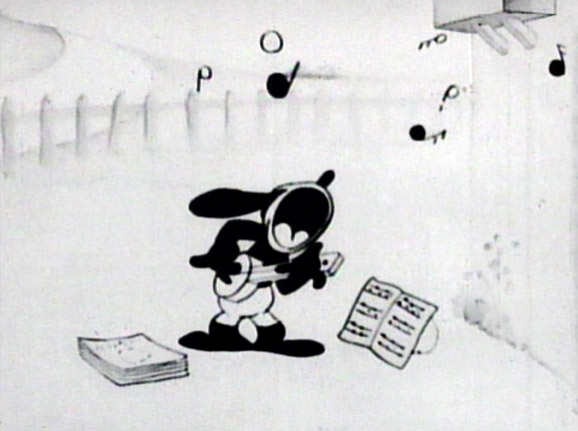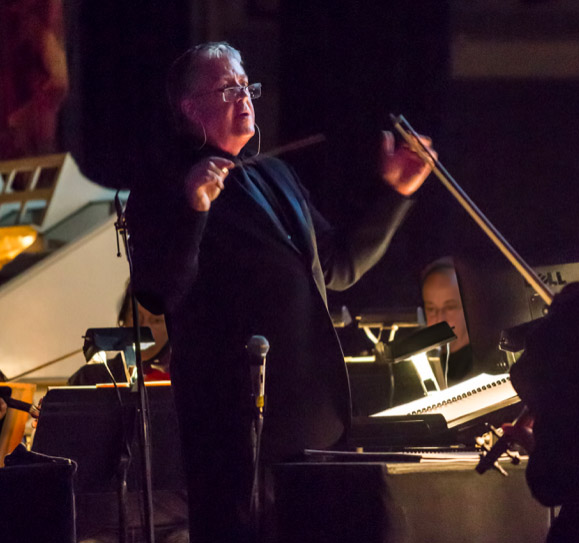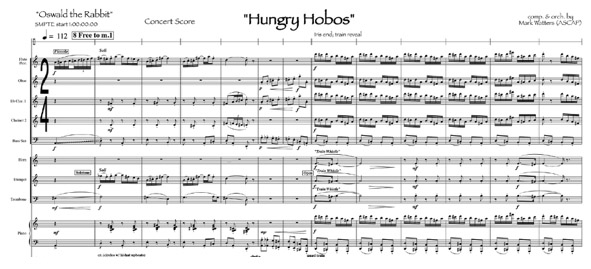
A still from the Oswald the Lucky Rabbit short, RIVAL ROMEOS, Premiere on February 26, 1928; general release on March 5, 1928. Disney
This is the third column of my three-part series on Oswald, which are expanded partial extracts from my new book, Oswald the Lucky Rabbit: The Search for the Lost Disney Cartoons. I must tell you right up front that I am not a musical person. Aside from playing the recorder in third grade, I dont play any musical instruments. But, I love music and listen to anything from classical to contemporary alternative rock and everything in between. I am also a fan of film soundtracks and am very attune to listening and appreciating movie music. To me, music is a supporting character to the screen action especially in the early days of cinema. So, it is an integral part of the restoration efforts on the silent cartoons and an aspect of the process that I find particularly enjoyable and satisfying.
Since these Oswald shorts are silent cartoons, there are no known music scores that have survived. I spoke with and had searched the music archives at Disney and came up empty; there are no scores. These shorts were released to theaters as silent films and it was the theaters resident musician, most typically on a Wurlitzer organ or a piano, who would play along with the picture being projected. In some instancesin larger citiesthere might be a small ensemble of musicians. The music would be different from theater to theater, with each theater music director bringing his or her own musical sensibilities to their performance and music scores. A good theater organist would be able to improvise as the film was playing. The larger theaters with full orchestras would also have musical directors who could compile scores from libraries of cues, then supply parts to the orchestra, the smaller ensemble, and/or the organist, said film historian J. B. Kaufman.
Because music is such an integral part of animation, a portion of the restoration efforts for the Oswald cartoons included having new scores created that were reflective of the film subject matter and story line, as well as being indicative of the time period when the films were produced. Existing silent cartoons have had music added consisting of a lone organ playing up to a small ensemble.

Mark Watters conducting his score for AFRICA BEFORE DARK at the 2015 Los Angeles Chamber Orchestra Silent Movie program; photo Jamie Pham.
In 2015, we screened two formerly lost Oswald cartoons as part of a Los Angeles Chamber Orchestra program, and I had the opportunity to write some program notes about the shorts and the music. According to six-time Emmywinning conductor/composer Mark Watters, Walt Disney’s philosophy regarding music was very simple. It should support the story!
Although there is no evidence of either Disney or Universal having created scores for the original Oswald shorts, it is easy to imagine what Disneys musical direction would have been, even for the theater organists who typically came up with their own accompaniment. Watters’ went on to say, If you listen to the earliest Mickey Mouse shorts, it is not hard to make that leap, especially for the ones scored by Carl Stalling, who was Walts first composer/music director. Animation was such a novelty in the late twenties, and music was used to highlight the comical antics of the characters, Watters added.
Watters explained, “The music that was originally used for these silent films were rarely original compositions but rather classical or popular pieces of the day. Animation was no different. Ragtime [and] popular dance music styles such as the fox-trot, the quickstep, and the Charleston were all used to show the fun and silliness of these early cartoons. Much of that music was public domain, which did not require royalty payments or licensing fees.”
“The science and art of synchronized sound had not been developed at this time”, Watters adds, “so music could only provide a general mood such as funny, dangerous, sweetness, patriotic, etc. The music itself was used to create an effect, to evoke emotion from the audience that was watching the film. It had to provide a visceral feeling that complemented the film, which in turn added to the overall theater experience.”
“Music was also used to provide location, in the most general of terms,” Watters continues. “For example, if the short took place on a farm, the music would often be a popular folk tune, such as Turkey in the Straw or Oh, My Darling Clementine. But,” the composer says, “If it took place in the city, then a lively jazz tune would provide the setting. These were the first steps in what would later be developed into the art form we know today as Animation Music.”

Sheet music from Mark Watters original score for the Oswald the Lucky Rabbit short, HUNGRY HOBOS. Note that it uses the common misspelling of the title by dropping the e in Hoboes. Disney
Watters composed the new music scores for Poor Papa, Africa Before Dark, and Hungry Hoboes. In discussing that music and its origins, Watters notes, “The first step is to find the right tempo. Each scene has a pacing to it, even if it was not intentional. Walt Disney enjoyed it when music would hit the specific action, though this can never appear to be forced. Yet it is a bedrock of cartoon music.”
Hungry Hoboes was the first reacquired Oswald short that Watters scored, and it was set in the Appalachian backwoods in a more rural jazz style, while Poor Papa has a pastoral home-style settingso jazz would not set the right tone. In Poor Papa, Watters used This Is the Way We Wash Our Clothes, Rock-a-bye Baby, and the well-known Brahms Lullaby (originally Wiegenlied: Guten Abend, gute Nacht). These classic childrens songs seem to fit the short best.
Africa was a popular inspiration for many of the big bands of the late 1920s – most notably Duke Ellington’s The Mooche, a great example of the jungle style (coincidentally also created in 1928 like the first three Mickey Mouse shorts). For Africa Before Dark, Watters chose to use the familiar tune, A-Hunting We Will Go, but modified it and other melodies to capture that same jungle style.
These Oswald the Lucky Rabbit shorts are excellent examples of animation that should be restored, preserved, and enjoyed by todays audiences. There is a lighthearted and imaginative freshness to these cartoons – a timelessness to the animation. And the use of popular music complements the screen action beautifully.
In particular, there is cleverness to the gags and a sense that there are no boundaries in what can be achieved in visual comedy through this medium of animation art and its musical accompaniments. When viewed in the context of overall animation history, these cartoons are a foundation for everything that came afterwards. In fact, it could be argued that the fresh originality of these early Oswald cartoons exemplifies the inventiveness, imaginativeness, and surrealist qualities inherent in animationthe anthropomorphic attributes given to inanimate objects, the ability for characters to be dismembered and reassembled, and for handy props appearing out of thin air and disappearing just as quickly. These are the hallmarks of early animated cartoons that continue to endure today for those who understand the fundamental roots of the animation art form.
Music is a vital part of complimenting and highlighting that screen action – it is a supporting character in animation. Without it, the gags and situations are diminished, incomplete to the viewing experience. Some may want to watch these silent cartoons with no sound. But for me, Id prefer a robust music score that is composed expressly for each individual cartoon so that I can be fully immersed in the animation experience. If you have not had the opportunity to see silent films with live musical accompaniment, I urge to jump at the next chance you get. Seeing these films in a vintage theater with a twenty-eight-piece orchestra is a completely immersive event and the best way to experience these cartoons.


 David A. Bossert is an award-winning artist, filmmaker, and author. He received his B.A. from CalArts School of Film and Video with a major in Character Animation. As a 32-year veteran of The Walt Disney Company, he contributed his talents to The Black Cauldron (1985), Who Framed Roger Rabbit (1988), The Little Mermaid (1989), Beauty and the Beast (1991), Aladdin (1992), Tim Burton’s The Nightmare Before Christmas (1993), The Lion King (1995), Fantasia/2000 (1999), and the Academy Award-nominated shorts Runaway Brain (1995), Dali/Disney Destino (2003), and Lorenzo (2004), among many others. Bossert is now an independent producer, creative director, and writer.
David A. Bossert is an award-winning artist, filmmaker, and author. He received his B.A. from CalArts School of Film and Video with a major in Character Animation. As a 32-year veteran of The Walt Disney Company, he contributed his talents to The Black Cauldron (1985), Who Framed Roger Rabbit (1988), The Little Mermaid (1989), Beauty and the Beast (1991), Aladdin (1992), Tim Burton’s The Nightmare Before Christmas (1993), The Lion King (1995), Fantasia/2000 (1999), and the Academy Award-nominated shorts Runaway Brain (1995), Dali/Disney Destino (2003), and Lorenzo (2004), among many others. Bossert is now an independent producer, creative director, and writer.













































































Oh, I would agree completely with what is said above. Since scoring was not originally thought of for silent cartoons, there was often no strict timing or “rhythm” to the cartoon other than to make sure that the comedy or drama was timed just right so that it would resonate with an audience through its visuals or pantomime. So all the score had to do was echo the mood of the scene. This sort of technique was also used in some of the very earliest sound films, whether live action or animation, because the new invention of synchronized sound was more reflected by sound effects and not so much for scoring because early sound equipment couldn’t accurately record such intricate instrumentation.
Oddly enough, even the earliest sound effects were created with musical instruments–a drum and bass plunked together to create the sound for a visual of, say, a large character falling with a thud to the ground or the tapping of the little bells of different pitches or chimes to represent the imagined tinkling of dewdrops falling. What must have been uniquely challenging for accompanyists on these OSWALD cartoons was actually creating that imagined pacing so that it would not overshadow or distract the visual. I would guess that some theaters did just run the cartoons with no accompaniment so that viewers could imagine what the sounds might be within the exaggerated comedy of the cartoon. After all, the sounds could not be that “realistic” because there is nothing flatly “real” about what you are seeing onscreen.
Many years ago, I saw the 1925 version of The Phantom of the Opera accompanied by live music on a Wurlitzer organ/ it was incredible!
Yes, I agree that seeing films accompanied by live music is a great experience. They are doing it more frequently now, even with more contemporary films like The Nightmare Before Christmas and The Little Mermaid, which were both done at the Hollywood Bowl. I wish there was more in the way of the silent films done this way as well. Thanks for your note.
“Poor Papa”, music by Harry Woods, lyrics by Billy Rose, created in 1926.
I was very disappointed that Mark Watters didn’t use the melody that obviously inspired the cartoon’s title! Don’t tell me that the rights couldn’t be cleared, or something like that!
As one who has played piano for silent films
(& cartoons), this post is a GIANT Treat. Thank YOU, Dave – and Jerry!
I’m glad that you enjoyed the post. Thank you for your note.
In my experience of silent film accompanist, transitioning to another scene is just as important as setting a theme for one scene as they help the audience prepare itself for what’s to come without spilling the beans.
In Disney’s Oswald shorts the mood between two scenes tend to change dramatically, and the composer and accompanist generally have two ways of dealing with transitions:
1. Conclude the musical phrase properly to get the audience geared up to any changes.
2. A short bridge passage that introduces the next cue and clues the audience in on what’s going to happen in the following scene.
I’ve had great pleasure reading this. Thank you for this great read!
Thank you for your thoughtful note and for reading this post.
I have that book since last year on Christmas! Speaking those cartoons, their early sound versions started off by Universal in 1931-1932 (or 1933) using new music scores and sound effects added. These versions can be found on some low-budget DVDs, being in the public domain. In 2007, a year after Disney required the rights to Oswald the Lucky Rabbit, Composer Robert Israel made brand new music scores for the DVD release. Between 2014 and 2017, newer music added to the remaining cartoons on some cartoon festivals, DVDs and Blu-rays.